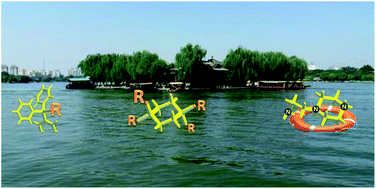Do alkyl groups on aromatic or aliphatic structure directing agents affect water stabilities and properties of hybrid iodoargentates?†
Abstract
Two types of in situ formed structure directing agents (SDAs) including aromatic triphenylphosphine (PPh3)- and aliphatic piperazine (H2pp)-derivative cations were used to synthesize five new hybrid iodoargentates, namely (EtPPh3)Ag3I4 (1, Et = ethyl), (n-PrPPh3)Ag3I4 (2, n-Pr = n-propyl), (i-PrPPh3)Ag5I6 (3, i-Pr = isopropyl), (Me4pp)0.5AgI2 (4, Me = methyl), and (H3app)2(Ag2I6)·2I·2H2O (5, app = N-aminoethylpiperazine). A comparative study of the two types of SDAs on the structures, stabilities and properties of hybrid iodoargentates was performed in detail. Structurally, except for (EtPPh3)+ and (n-PrPPh3)+, which both directly form (Ag3I4)− anionic chains in 1 and 2, three SDAs generate hybrid iodoargentates different from each other with inorganic anions ranging from a 0-D (Ag2I6)4− dimer to 1-D α-type (AgI2)− and (Ag5I6)− chains. With regard to the electronic structures, aromatic PPh3-derivative cations make noticeable contributions to the bottom of the conduction bands, while aliphatic pp-derivative cations make nearly no contribution to the frontier orbitals, clearly indicating their different ways to adjust the band gaps. With regard to stability, the decomposition temperatures of 1–3 in the range of 324–349 °C are noticeably higher than the values of 217 and 225 °C for 4 and 5. Furthermore, 1–4 exhibit good water stabilities, which is ascribed to the alkylation reactions precluding the formation of strong hydrogen bonds between alkylated SDAs and extraneous H2O molecules. Contrarily, the presence of typical hydrophilic ![[double bond, length as m-dash]](https://www.rsc.org/images/entities/char_e001.gif) NH2+,
NH2+, ![[triple bond, length as m-dash]](https://www.rsc.org/images/entities/char_e002.gif) NH+ and –NH3+ groups on the protonated (H3app)3+ cation makes 5 sensitive to water and a hydrolysis reaction occurs to generate a cubic AgI phase. Finally, 1–3 exhibit high photocatalytic efficiencies for the degradation of rhodamine B (RhB) dye in wastewater under visible light. All conclusions obtained here will help a lot in the synthesis of stable functional metal halide-based hybrids.
NH+ and –NH3+ groups on the protonated (H3app)3+ cation makes 5 sensitive to water and a hydrolysis reaction occurs to generate a cubic AgI phase. Finally, 1–3 exhibit high photocatalytic efficiencies for the degradation of rhodamine B (RhB) dye in wastewater under visible light. All conclusions obtained here will help a lot in the synthesis of stable functional metal halide-based hybrids.



 Please wait while we load your content...
Please wait while we load your content...